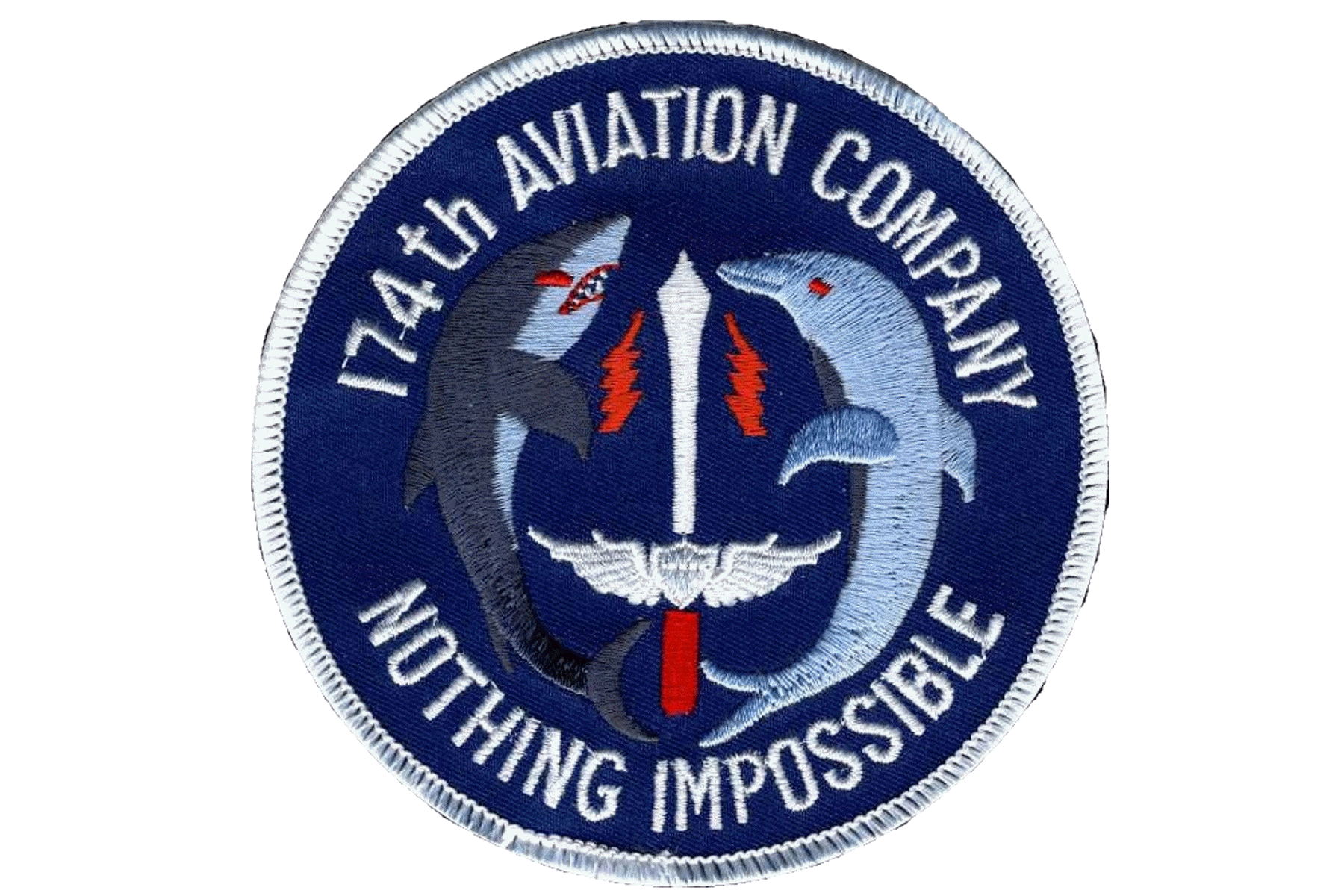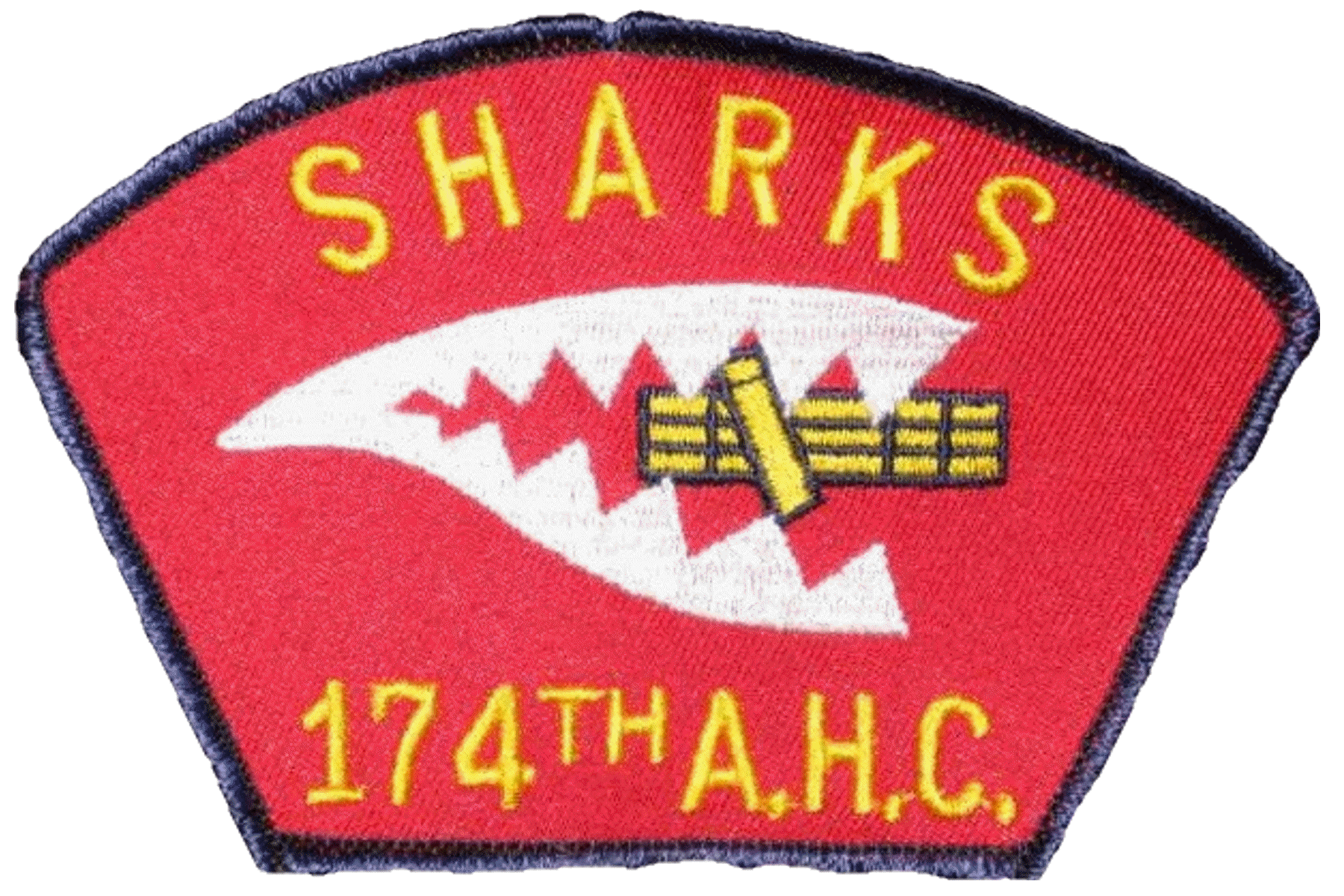174th Assault
Helicopter Company
DOLPHINS & SHARKS
The Crash of Dolphin 946
(Or: How To Get Shot Down And Not Know It)
Webmaster note: The source for much of the below story is the unpublished narrative accounting of Jim McDaniel's first tour of duty in Vietnam in the 174th AHC in 1967-68, compiled by his wife, Charlotte (Char), after many hours of interviews with Jim as well as considerable independent research on her part.
On September 26, 1967, after being in the 174th for about four months, WO1 James I. McDaniel
was involved in his second helicopter crash in a Dolphin. In fact, he was flying in the same
UH-1D helicopter that he and WO1 Carmichael were flying when they crashed in June 1967, less
than a month after Jim started flying in Vietnam. That particular aircraft, Dolphin 946 (65-09946),
had a reputation for having a weak engine. In the post-crash investigation of that crash, the
maintenance personnel found "a hole rusted in the diffuser section of the engine." The engine was
replaced.
Dolphin 946 first joined the 174th as a new UH-1D in October 1966 and had acquired 1115 hours by September 1967.
Jim was flying as the Aircraft Commander on that September day and his copilot was WO1 Steve Buzzell.
They were flying resupply missions for "A" Company, 2/35th Infantry.
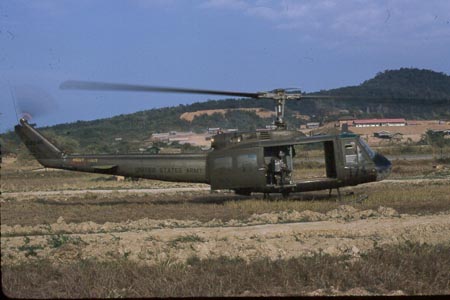
Photo by Major Derald Smith
Buzz later transferred to the 71st AHC and flew Firebirds. The first two photos below are of Jim and Dolphin 946
at the southeast resupply pad at Duc Pho. These photos may have been taken the day of the crash, for Jim did have
his camera with him and had taken some photos that day. The crew chief, or one of the grunts at the resupply pad,
may have taken these with Jim's camera.
A day or two earlier, the 174th had participated in a combat assault, and they had put A Company troops down
in a valley LZ in the mountains. The troops were working their way up a mountain and needed to be resupplied.
So, earlier that morning, another Dolphin helicopter had flown over their position and, while hovering over the
jungle canopy, lowered a chain saw down through the trees with a rope. The troops on the ground got it and found
a somewhat flat place about 50 meters from the top of the mountain. There, they cut a landing zone in the jungle
for the helicopters to come in and bring them supplies.
The area that was cleared was just a little bigger than the diameter of the rotor blades on the helicopter.
We called those types of LZ's "hover holes," as you'd have to executed an approach to zero airspeed at the top of the
opening in the trees, center yourself over the hole, then execute a vertical descending hover to the jungle floor.
Usually the crew chief and gunner would be talking to the pilots and directing us as we descended, to keep the
vulnerable tail rotor clear of any tree limbs or branches. Even a small branch would be enough to destroy a
tail rotor, resulting in an uncontrollable spin inside the hover hole. NOT a good thing.
Several helicopters from the 174th were bringing in supplies that day. The weather was bad. It was cloudy, overcast
and drizzly. On Jim's first sortie (trip) into the hover hole, he was successful even though they were clipping
leaves and branches off the trees because the hole was so small. Jim estimated the trees were between 50 to 100 feet
tall in the area.
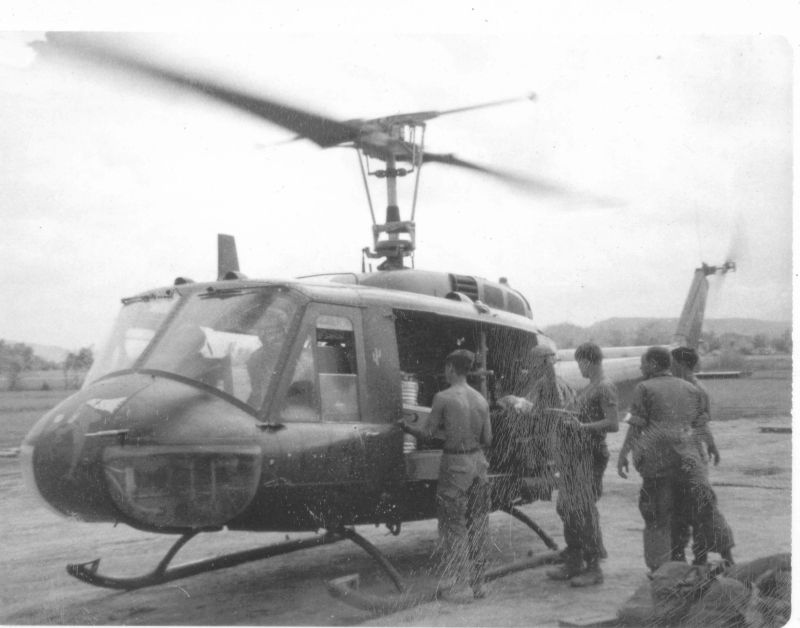 In Jim's accident statement written for the Army several weeks after the crash, he stated -- "On 26 September 1967
I was flying as Aircraft Commander on Dolphin 946 on a resupply mission for 'A' Company 2/35 Infantry. 'A' Company
was located on a mountainous area in thick jungle-type growth. An L.Z. had been cut out on a relatively flat spot
near the top of the hill. Resupplies were being brought to this L.Z. by myself and three other helicopters of the
174th Avn Co."
In Jim's accident statement written for the Army several weeks after the crash, he stated -- "On 26 September 1967
I was flying as Aircraft Commander on Dolphin 946 on a resupply mission for 'A' Company 2/35 Infantry. 'A' Company
was located on a mountainous area in thick jungle-type growth. An L.Z. had been cut out on a relatively flat spot
near the top of the hill. Resupplies were being brought to this L.Z. by myself and three other helicopters of the
174th Avn Co."
"A thick cloud layer was in the area but had not yet reached the L.Z. on my first sortie. The L.Z. was very tight
and great care had to be executed in landing and taking off. On the first landing the clouds were about 300 meters
from the L.Z. and slowly advancing on it. The wind was light and generally from the southwest. There was a matter
of just a few feet clearance for the blades and take-off was a vertical climb over 50 foot trees."
Jim's crew chief on that flight, SP4 E4 Daniel R. Dixon, had this to say in his statement written after the accident
-- "With the first sortie aboard we made our departure for alpha company with the other ship in front of us. Upon
arriving we had to circle around waiting for C/C [the command and control helicopter] to leave the L.Z. When C/C
left the first resupply ship made his drop off. By this time the clouds were moving in over the mountain but we still
had a clear L.Z."
"Now we were going in on final approach. With the careful guidance of myself and my gunner we cleared in the pilot.
Upon landing we found we had to hold pitch [because of the uneven terrain and the tree branches and trunks across the
LZ]. Upon unloading we made our straight vertical take-off above the trees."
After that first successful sortie, they flew back to Duc Pho to pick up another load for the troops on the mountain.
That time they picked up several cases of mortar rounds and hot food. The hot chow was fixed in the mess hall and
put in mermite cans which were insulated containers for mess hall food. They also picked up one soldier who was going
back to the unit in the field: a big, muscular black man who sat on the cases in the back. Because we were on a resupply
missin, we had removed all seats and seat belts from the cargo area of the helicopter -- normal procedure.
As they tried to take off, they realized that the aircraft was overloaded. Generally, if they could hover without losing
more than 400 engine RPM, they would go. If not, they landed and took off some weight. That particular time they
lost exactly 400 RPM, but then stabilized. So, they accepted that load and continued on with the sortie.
It's interesting to note that, given today's knowledge of turbine engines and operational procedures, the method
for determining a "go" or "no-go" decision in 1967 would be quite unacceptable today and would be considered unsafe. It
gave no reserve power or margin for error. The helicopter was so overloaded at takeoff that the engine could not even
maintain operating rotor RPM at a hover in ground effect at sea level. There was absolutely no margin for error. Flying
to a mountain top hover-hole and having to establish an out-of-ground-effect hover and precision decending hover on a mountain
side would certainly be a challenge to the most experienced of pilots. They had done it once that morning already,
and were out to try it one more time.
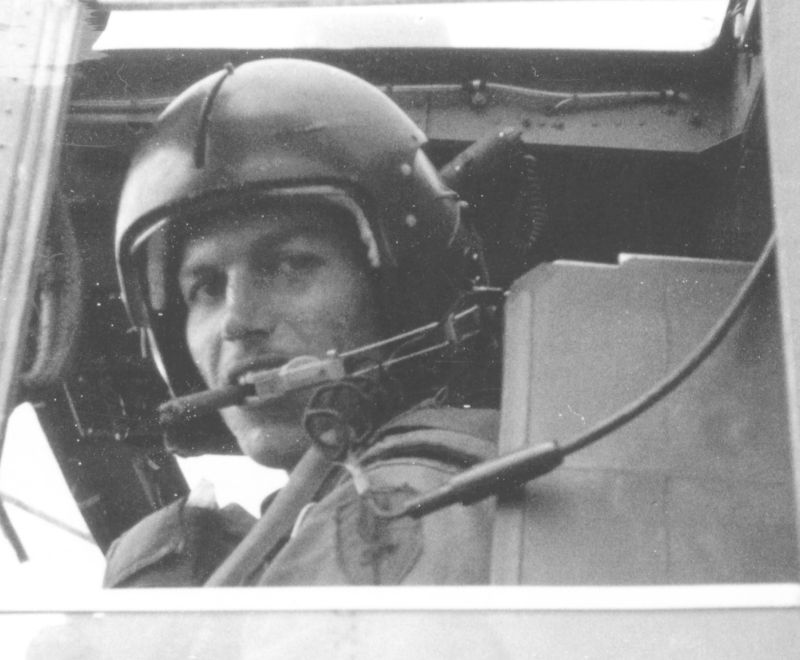 Dixon stated -- "We departed for alpha company with two other ships following behind. Upon arrival to the location
we found the clouds moving in fast. The pilot had decided not to make the landing because of possibility the clouds
would cover our take off."
Dixon stated -- "We departed for alpha company with two other ships following behind. Upon arrival to the location
we found the clouds moving in fast. The pilot had decided not to make the landing because of possibility the clouds
would cover our take off."
Jim's statement continued -- "Upon return to the area for the second sortie the clouds had closed in over it but were
still 50 to 100 feet above the L.Z. The top of the hill was in the clouds. We were the first aircraft back in the area
for the second sortie and had some difficulty locating the L.Z. We were flying just below the cloud layer, down a
valley, and were in an almost horizontal sight plane with the L.Z., at most a hundred feet above the L.Z. and, at that
time, at least half a mile out. Upon locating the L.Z. I began the approach, and was approximately 100 meters from
it when I executed a missed approach, 'falling off' to the right-rear and back down the hill. A landing could have
been successfully completed but I felt the clouds could have closed in on the L.Z. before the aircraft could be
unloaded, making it impossible for a VFR [visual] take off."
On his FM radio, Jim contacted the ground unit and told them of his decision to not attempt the landing. "Upon
completion of my call the aircraft orbiting with the next sortie elected to try, so I orbited in the valley while he
went in on approach. He informed me that the cloud layer was covering the tip of the hill but the L.Z. was still
clear, with a very low ceiling, and he landed and unloaded his supplies. When I saw him leave the L.Z. I elected to
try again for the clouds did not seem to be advancing down the lee side of the hill as fast as I first expected.
I completed my 360 degree orbit for the other aircraft to clear my approach path, then started in."
The weather had been getting worse as the day went on. As they approached the LZ, Jim couldn't find it, and neither
could Steve Buzzell, his co-pilot. The clouds were at the top of the mountain, and the landing zone was just below that.
They couldn't get up high enough to spot the hole carved in the trees. They talked to the troops on the ground,
and the ground radio operator said the clouds were not yet on the treetops at the LZ.
Jim's accident statement continued, "After turning in on final I could not locate the exact L.Z., but could distinguish
the area of it. The ground unit informed me he had me in sight and I was coming in straight to the L.Z. After a
moment he came back on and said I was drifting a little west, so I corrected 3 to 5 degrees to the left. My approach
was to the southwest. I would estimate we were on half mile final when he said we were still too far west, so I
corrected more to the left. A few seconds later he came back on and said we were going further west. In the middle
of this transmission he corrected himself and admitted he was 180 degrees out of phase. He had been turning us
away from the L.Z.
"We were not yet committed, and I was preparing to go around again, when the co-pilot located the L.Z. I had not
yet located it when he said it was at our 1:00 position and he felt we could make it. I gave him the controls and
he continued the approach.
"The top of the hill was still in the clouds and I may have been looking either too high or too low, but I still
could not see the L.Z. The co-pilot continued the approach nearer the hill side just below the cloud layer.
"The airspeed began dropping off as though we were making a deceleration prior to coming to a hover. When it reached
35 knots and I still couldn't see the L,Z., I commented to the co-pilot about it. He started getting airspeed back
but the RPM began to drop (because he was pulling maximum power and we were at very low airspeed). The RPM continued
to drop slowly and I still could not see the L.Z. We were about 50 feet above the jungle canopy so I took the
controls and attempted to go around. The RPM had reached 5800." [Normal operating RPM was 6600.]
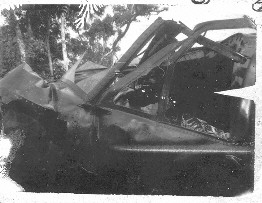 It takes more power to hover a helicopter than to fly with forward airspeed. The reason for this, basically, is
because as the helicopter moves through the air at a high forward airspeed, the blade that is advancing in the
direction of flight is "cutting into" clean, undisturbed air. At a hover, both blades are constantly rotating
in the "wake" of the blade in front of it, and a blade rotating through disturbed or turbulent air is not as
efficient and does not produce as much lift as a blade advancing through undisturbed or still air. With forward
airspeed, the increased efficiency of the rotor and the increased lift it produces results in less power required
to fly.
It takes more power to hover a helicopter than to fly with forward airspeed. The reason for this, basically, is
because as the helicopter moves through the air at a high forward airspeed, the blade that is advancing in the
direction of flight is "cutting into" clean, undisturbed air. At a hover, both blades are constantly rotating
in the "wake" of the blade in front of it, and a blade rotating through disturbed or turbulent air is not as
efficient and does not produce as much lift as a blade advancing through undisturbed or still air. With forward
airspeed, the increased efficiency of the rotor and the increased lift it produces results in less power required
to fly.
So, a helicopter can in fact fly when it is too heavy to hover. This has resulted, especially in loaded Huey
gunships that take off overloaded as a matter of routine, in the "bouncing" or "sliding" takeoff. Here the helicopter
will be picked up to a hover and will start moving forward as in a normal takeoff. As it does so, in a hover, the rotor
RPM begins to decrease because the engine doesn't have enough power to maintain the RPM needed to hover. While moving
forward at a hover, as the rotor RPM decreases, the pilot will then allow the toes of the skids to touch the ground and
slide on the surface. Because the ground is now actually supporting some of the weight again, the result is that the
helicopter is "relatively lighter" and the engine doesn't need as much power to lift it. This results in the rotor RPM
building back as the helicopter slides along with it's skid tips in contact with the ground (again, all the weight is
no longer being supported by the rotor system -- part of it is again being supported by the ground). When rotor RPM
returns to normal -- while still moving forward at a "sliding hover" -- the helicopter will again be picked to a hover
and continue to accelerate. But again RPM will begin to decline. This procedure may be repeated several times until
airspeed is high enough for the advancing blade to begin to cut through the undisturbed air. It is very noticeable when
this occurs and is mostly recognized by a shuddering feeling that feeds back through the control system, a slight pitch-up
in aircraft attitude as lift is increased from the blade toward the front of the helicopter, and a reduction of power
required to maintain the same altitude. This transition from hovering to forward flight occurs generally around
15 knots of forward flight and is known as "translational lift."
When Jim took control of the helicopter again the airspeed was very low and he was approaching translational lift from
the top side -- meaning he was transitioning from forward flight back to hovering flight. He planned to abort that
approach, come back around and try to find the LZ again. At that point he was 10 to 15 feet above the trees and had
about 20 knots of forward airspeed. The rotor RPM stabilized around 5800 and remained there. The big red "LOW RPM"
warning light was illuminated, indicating critically low RPM, and Jim's earphone in his helmet blasted out that
very familiar warbling noise that also warned of critically low main rotor RPM.
To trade off altitude for airspeed, which they needed to regain rotor RPM, Jim turned away from the LZ and started
descending down the mountain slope toward the valley below. They were still very slow and descending down the mountain
at about the same rate as the tree tops on the slope were descending. This kept their relative distance above the tree tops
constant at only 15 to 25 feet. As they flew down that mountain side just a short distance, maybe only several hundred
feet, Jim heard a series of loud popping noises. At that same time the rotor RPM decreased rapidly.
They continued to descend down the side of the mountain, with rotor RPM continuing to decay. Within what seemed like
just a few seconds of the low RPM audio noise in his earphone and the light coming on, as he started down the slope, and
about the time of the series of loud pops, the tail rotor RPM got so low that it lost its effectiveness. The tail rotor is
critical in maintaining directional control, and at low airspeed when it decays to a point it is no longer effective, the
helicopter begins to spin.
At this point Dolphin 946 began a slow, lazy spin to the right. Jim continued descending
the mountain, in a slow spin, trying to get their airspeed up to rebuild the RPM. But, as they continued descending
the mountainside they continued to do "360's," spinning in circles ever faster. Jim's not sure how many times they
spun around (seemed like ten or more but could have been only half that), but it became obvious to him that he could
not stop the spinning, and that he was just before losing total control and crashing into the trees.
In his accident statement, Jim said, "I started a right turn, attempting to relieve some stress on the engine and
regain RPM, and began falling back down the slope. The RPM continued to drop and I could not get any air speed
built up although we were dropping in altitude. I was still trying for airspeed about 25 feet above the canopy when
I lost directional control."
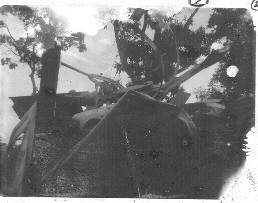 "At this time I realized we couldn't get out [and were going down], so my attention turned to where I could set the
aircraft down. Slightly down the slope, in the direction we were headed, was a break in the canopy and the ground
looked relatively level. It was the only place that I could see through the canopy, and the trees in the area
appeared at least 50 feet high. There was just room to get the bulk of the helicopter through the trees but no hope
of the blades clearing."
"At this time I realized we couldn't get out [and were going down], so my attention turned to where I could set the
aircraft down. Slightly down the slope, in the direction we were headed, was a break in the canopy and the ground
looked relatively level. It was the only place that I could see through the canopy, and the trees in the area
appeared at least 50 feet high. There was just room to get the bulk of the helicopter through the trees but no hope
of the blades clearing."
His accident statement continues -- "I headed the aircraft for the area with cyclic then applied full right pedal.
This increased our spinning but I believe it built a few RPM back, for when I got over the area (a matter of just
a few seconds) I slammed in full left pedal and the spinning stopped long enough to get the aircraft stationary and
level. As the aircraft began settling I held it a foot or two above the tallest tree in my field of vision until
all lift was lost and we fell through. I managed to get a quick mayday call before impact.
"I observed the outer four or five feet of the blades sheer off on a tree top, then it felt as if it [the helicopter]
exploded. The cockpit seemed to collapse and I received a blow on the head. My flight helmet softened it and I was
just a little stunned. I felt no pain but it took a second or two to get my senses."
Jim brought the helicopter to a momentary hover beside the tallest tree in the immediate area, which appeared to be
four or five feet outside of Jim's door on the left side of the aircraft. Jim held the aircraft there for a few
seconds, with the rotor blades just above the top of that tree. Then, when all lift was lost and the aircraft fell
through, the main rotor blade hit that tree about half way out the blade. The outer half of the rotor blade broke away.
Jim remembers looking out his window and watching the sheered-off rotor blade just sort of hang there in space, against
the tree, as the remaining blade attached to the rotor hub sped out of view. Rather surrealistic. Because the
other (undamaged) rotor blade was still intact and at full weight, the rotor system was then extremely out
of balance. This extreme out of balance condition tore out the engine and transmission mounts as the blade came forward
toward the cockpit, and the transmission began to be pulled forward into the cargo area of the helicopter.
The undamaged rotor blade drooped down and entered the cockpit from the right side, essentially cutting off the top
of the helicopter directly above Buzzell's head (who was sitting in the right seat). It continued its downward arc
through the cockpit, right-to-left, toward Jim in the left seat. All of the overhead switches and circuit breakers
between the two pilots were torn out and forced down on Jim's right arm and shoulder. The blade continued its downward
arc and actually hit Jim in the back of the head. Jim's head was turned to the left at the time, looking out the
window and still watching the other rotor blade after it sheared off against the tree, and the blade that came through
the cockpit hit the back of his helmet. The blow literally rotated his helmet off of his head, and the helmet exited
the aircraft either through the left window or out where the top of the aircraft used to be.
"We continued a rather wild ride to the jungle floor. Actually, I don't remember a whole lot about it, 'cause it
knocked me a bit silly."
It didn't knock him out completely, however, because Jim remembers the vertical impact as they hit the floor of the
jungle. Each rotor blade was then only about three or four feet long (see the photo that shows the rotor hub
and remaining three-foot rotor blades), but the metal leading edge strip of each rotor (about 10-feet long or so) was
still attached. The result was that each rotor "stub" had a steel whip attached to it.
The helicopter had fallen in a mostly level position straight down between the trunks of trees that were 50 to 100
feet tall. With most of the blades (and weight) now gone, the engine (that was still running) was at full throttle and
began to really wind up, severly over-speeding. "The remaining blades were like whips thrashing around on top of
the helicopter making a hell of a racket!"
 Jim was still barely conscious from both the rotor blade impact to his head and the impact with the jungle floor.
Dixon, his crew chief, jumped out after they hit the ground and came over and got Jim's damaged door open. Jim then
managed to shut down the aircraft "which was kind of hard to do because all the overhead switches were down on my arm
and shoulder."
Jim was still barely conscious from both the rotor blade impact to his head and the impact with the jungle floor.
Dixon, his crew chief, jumped out after they hit the ground and came over and got Jim's damaged door open. Jim then
managed to shut down the aircraft "which was kind of hard to do because all the overhead switches were down on my arm
and shoulder."
The top of the aircraft was gone! None of the electrical switches worked. But, some of the other controls did.
Jim also remembers that he could not find the collective pitch control to roll off the throttle and stop the rotor blade
from thrashing around. The crash forces had been so severe that the collective was bent at 90 degrees (straight up)
and, not being in its normal position, Jim couldn't find it in his groggy condition. He managed to get the fuel
shut off to the engine by turning off the master fuel switch on the center console.
The engine stopped. There was no post-crash fire. With the help of Dixon, Jim then got out of the
helicopter.
Dixon put it this way in his statement -- "After our 100 foot drop the helicopter came to a [stable] position and
I [leaped] from my seat to aid the A/C. The gunners was the same immediate reaction. The pack [passenger] aboard I never
saw leave the ship, the gunner did. After I saw no injury to the A/C he shut down the still running engine and head was
still turning. After he had
stopped we departed the aircraft to safety."
Jim's statement continued -- "Just after the aircraft came to a stop, within a matter of seconds, the crew chief was at
my door assisting me. The door gunner and crew chief both appeared unhurt and the pilot, although bleeding from the
mouth and nose, said he was not hurt seriously.
"I felt no injuries so I started shutting down the aircraft. About three feet of blades remained, along with six or
seven feet of metal from the leading edge, and was thrashing the top of the aircraft. It took a few moments to locate
all the controls, for the overhead panel was between the two seats. After getting it shut down I got out of the aircraft
and everyone moved a safe distance from it. I located the portable emergency radio before leaving and turned it on as
soon as I got away from the aircraft.
| Jim's helmet with black paint marks on the back of the helmet from the main rotor blade impact to the back of his head when the blade came through the cockpit, and secondary impact scuff marks on the front of the helmet. Whether the secondary scuff marks were received before or after it left Jim's head is not known, he was too groggy to tell. |

Jim continued -- "The ground troops were in the area by the time we cleared the crash site, and set up a perimeter and
administered first-aid. One of the troops had a back radio and was in contact with the rest of the company, so I
turned off the emergency radio."
While they were still about one hundred feet up in the air, the soldier in the back (their lone passenger) had apparently
seen enough, and he decided his chances were better NOT being in the helicopter.
He jumped out!
It happened when Jim had managed to get the helicopter to stop spinning momentarily. He jumped from the down-hill side
of the helicopter. He survived his jump onto the jungle floor. By the time Jim crawled out of the helicopter, that
soldier had climbed back up to where they were and was assisting in securing the aircraft. His addrenlin had to be
SKY HIGH!
That was certainly an unlucky day for Jim and the crew of Dolphin 946, but they also had a bit of good luck thrown in.
They almost fell on top of an American patrol from the unit that they were supporting. Alpha Company had earlier been in
contact (combat) with Viet Cong (VC) units in the area, and there were Viet Cong still in the area. By the time Jim and
Steve Buzzell had gotten out of the aircraft, the American troops, who were out on patrol looking for the VC, were
already there and had set up a security perimeter around the helicopter. Jim had almost crashed on top of them.
The crew chief said -- "Then after no chance of fire we went to the ship and removed the machine guns, radios, and
valuable papers. I asked my gunner to try to find my Log Book but could not." In Jim's statement he noted --
"It appeared the aircraft would not burn so we returned and began disarming it of its machine guns and removing the
radios. We had some difficulty removing the radios for the front end of the aircraft was badly damaged. The sides
of the radio compartment had to be banged out with rifle butts to permit removal of the radios. There were no large
pieces of glass left anywhere in the cockpit, for the roof had been sheered off above both pilots' heads by the main
rotor blade."
Jim had a couple of puncture wound holes poked in his right elbow and forearm from the overhead instrument panel
switches when the rotor blade came down on him, and he was bleeding some from those wounds. He had hurt his back
during the impact with the ground, but he was able to move around OK following the crash. His head and neck were also sore
and he had a deep bruise on his chin, probably from when the rotor blade hit his head early on. Everyone's addrenlin was high.
What didn't show up for several days were many of the bruises. The insides of his knees and thighs were really bruised and
sore from the cyclic control slamming back and forth from the crash forces and the destruction of the rotor system,
and his shoulder and back became much more painful in the following days. Jim's co-pilot, Buzzell, broke his wrist
and possibly his jaw. He was bleeding from his mouth and nose, but didn't appear to be seriously injured. Basically
he was OK and recovered just fine. Amazingly enough, the two crew members (crew chief and gunner) in the back and
the soldier who had jumped out were uninjured.
Jim described their injuries in his accident statement this way, "The ground troops had been administering first-aid
to the pilot, and had his left hand in a splint. Broken plexiglass was used. His wrist appeared broken, he had
light cuts on his face, arms and legs, and numerous bruises.
"My right arm was bleeding from two puncture wounds, one in the elbow and one in the forearm. They did not appear
serious and were dressed by the ground troops. I also had bruises on the chin, right arm, right leg and both knees
but these did not become evident until later. The two crew members and our one passenger were uninjured."
After they retrieved the radios, paper work and machine guns from the ship, the American troops escorted them up to
the landing zone that they had been trying to find. It took them about an hour or so to get up the steep, thick
jungle mountainside, although they weren't far from it, maybe 100 yards away. Surprisingly, by the time they
reached the LZ site, the unpredictable Vietnam weather had cleared and the cloud layer had dissipated. Another
Dolphin helicopter picked them up as soon as they got there and took them to the Medivac pad at Duc Pho. Within two
hours of the crash, they were all back "home."
Dixon ended his statement, "Then we started our trip to the L.Z. Upon arrival to the L.Z. we were soon picked up
with the crew, guns, radios and papers. To my fullest knowledge that was all the happenings of the accident."
It was dated October 11, 1967 and signed Daniel R. Dixon, RA19847301, SP4 E4, 174th Avn Co (AML). AML stood for Air
Mobile Light. The term was changed later at some point to Assault Helicopter Company (AHC).
Jim ended his statement this way, "After the first-aid was completed we started through the jungle for the L.Z.
The majority of the troops secured the aircraft while a squad provided a security force to accompany us. When we
reached the L.Z. the cloud cover had mostly lifted. One of the resupply ships came in to lift us out and we were
flown to the med-evac pad at Duc Pho." The statement was signed, James I. McDaniel, W3156283, WO1, 174th Avn
Co (AML).
| This map shows the approximate location of the crash site, which was southeast of Minh Long firebase, southwest of the village of Mo Duc, and northwest of LZ Liz. It is identified by the small circle just to the right of the word "crash" on the map. The hover hole would be just to the west (left) of the circle, near the bottom of the letter "H". |
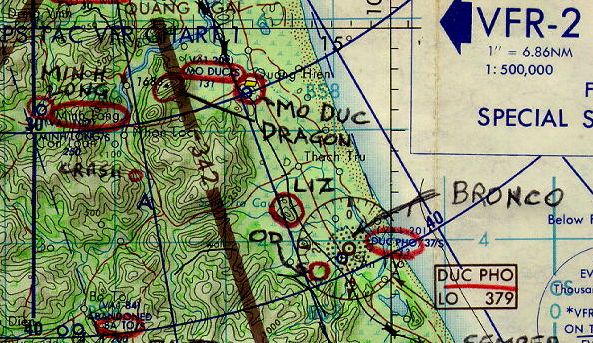
The first thing they did upon arrival at Duc Pho was to go to the doctors at the dustoff (Medevac) facility (a field
clinic of sorts). They landed at the dustoff pad near the 174th company area. Jim got his arm bandaged. Duc Pho
had a dispensary for the 174th, where Jim usually went, and a separate dustoff medevac unit that was not part of the
174th. It just so happened that he got treated at the medevac site on that day. Although the two medical facilities were
less than a city block apart, the medical records from that visit never made it back into Jim's official medical
records at the 174th dispensary. There was no additional treatment provided at the 174th dispensary for the bruises
that later appeared, so no later medical treatment was entered in his medical records either. To this day there is
no mention of the crash or those injuries in his official Army medical records.
After tending to his injuries at the dispensary, Jim had to go see his company commander, Major Tom Wheat, and explain to
him what had happened. Jim explained the accident to his commander and provided him essentially the same description he
later put into his accident statement.
Jim was grounded from flying for almost a month until his arm healed and his extensive bruises subsided. Because he
couldn't fly, Major Wheat sent Jim to Saigon for a few weeks on a scrounging mission to get some equipment for the
unit. Jim began flying again on October 24, 1967.
The maintenance officer told Jim, some time after he returned from Saigon, that when he had inspected the
helicopter he found a bullet hole in the engine, through the diffuser section of the engine. That is what caused
them to lose power so abruptly. Even though Jim had heard the popping noises while they were low and slow over the trees,
looking for the landing zone, he didn't realize that they were being shot at, and had been hit. Jim thought the popping
was a "compressor stall," which sometimes occurs in the compressor section of a turbine engine when more power is
demanded from the engine than it is capable of giving, especially in high altitude or high density conditions.
The popping sound it creates sounds somewhat like a weapon being fired, especially the popping sound from the
"pointy-end" of a gun. While they had clearly gotten themselves into a bind during this approach, trying to get
the supplies to the troops in such poor weather conditions, Jim felt he may well have been able to fly out of their
situation had not the VC complicated the situation with a bullet in the engine.
Jim did not know of the bullet in the engine so made no reference to it in his report to either his commander or
in his later written report. Jim was never told at the unit that an accident investigation (such that it
must have been) had ever been done, nor was he ever told the results. Jim finally saw a short summary of an
accident investigation report on this crash in the 1990s, when he saw the U.S. Army's "Goldbook" report
on the accident. He did not know he had essentially been sited as the cause of the accident. It was the classic "pilot
error" answer. This really surprised Jim, for he considered the crash a combat loss and never questioned it.
Here is the rather cryptic description still in the U.S. Army's Goldbook data base about this accident:
Information on U.S. Army helicopter UH-1D tail number 65-09946
The Army purchased this helicopter 0666
Total flight hours at this point: 00001167
Date: 09/26/67
Accident case number: 670926121 Total loss or fatality Accident
Unit: 174 AHC
South Vietnam
Number killed in accident = 0 . . Injured = 2 . . Passengers = 0
costing 228554
Original source(s) and document(s) from which the incident was created or updated: Defense Intelligence Agency
Helicopter Loss database. Army Aviation Safety Center database. Also: OPERA (Operations Report.)
Loss to Inventory
Crew Members:
AC W1 MCDANIEL JI
P W1 BUZZELL SR
CE E4 DIXON DR
G NO NAME
Accident Summary:
The aircraft commander allowed the PRM to deteriorate on approach to an LZ. The aircraft lost additional RPM on a go
around and the aircraft crashed in trees. The aircraft was destroyed in place.
Some time later (several years), when it occurred to Jim to maybe pursue a purple heart as a
result of the crash, he ran into trouble. Major Wheat, who had investigated Jim's crash, had been killed in an airplane
crash back in the States in the early 1970's. With the medical records of his injuries and treatment lost, Jim decided
to just let it drop.
In a conversation with Larry Martin in August 1996, shortly after the reunion at Santa Clara of the Vietnam Helicopter
Pilots Association, Larry (who became the 174th maintenance officer in 1968) told Jim he remembered having some paperwork
from CPT Goff, the maintenance officer at the time, that stated they had discovered a single bullet hole in the diffuser
section of the engine -- the result of which would be an immediate and substantial loss of power, even though the
engine would continue to run. As the aircraft was blown in place, the "minor detail" of the bullet hole in the engine
never made it into the accident investigation report. Larry looked for that paperwork for Jim, but after almost 30 years
was unable to locate it.
What Jim didn't know when he wrote his accident statement was what the unit's assistant maintenance officer, W01
Dennis McCormack, found at the crash site. The next morning after the crash Dennis went to the crash site to evaluate
whether the helicopter was recoverable. If so, they were going to call in a 178th Assault Support Helicopter Company's
"Box Car" Chinook helicopter to sling load it out of the jungle. What they found was that all the engine and
transmission mounts were broken loose when the one rotor blade sheared off and the other blade came through the
cockpit during the crash. There was no way to sling load the helicopter out. So they decided to strip off the old bird
anything they could salvage, and leave the hulk there. After stripping it, Dennis put plastic (C-4) explosive in the
fuel cell and blew up the helicopter right there in the jungle. (Incidentally, Dennis removed the cyclic control grip
[you can see in one of the photos that it has been removed] and he presented it to me later. I still have that cyclic
grip today. Thanks again Dennis.)
Crash worthy fuel systems were just being introduced in Vietnam during Jim's first tour. They consisted of rubberized
bladders inside of the fuel tanks that were designed to withstand crash forces and to be somewhat self-sealing when
hit by small caliber bullets. This helicopter had one of those new fuel systems. Otherwise, had they not had the
crashworthy fuel system, Jim feels the crash forces were great enough that the fuel cells might well have ruptured
and it could have caught fire and burned when they hit the ground with the engine still running wide open.
When Jim was on his second tour of duty in Vietnam in 1971 as a Captain, back in the Americal airspace again, he thought
of that crash. He was curious. When the opportunity presented itself, he went to find that downed ship. The blown up
helicopter was still there, barely visible in the LZ Jim had created "for emergency use only" four years earlier,
and it was all overgrown with vegetation. The coordinates were BS 615 450.
![]() Return to top of: 1967 History Page.
Return to top of: 1967 History Page.
![]() Return to top of: Home Page.
Return to top of: Home Page.
